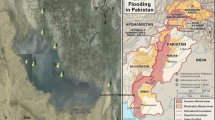Abstract
Inle Lake is the second largest lake in Myanmar and one of the nine key sites for sightseeing there. An analysis of its water quality has not been published before. The objective of this study is to reveal the current situation and find any major problems with the lake. For this purpose, the natural and cultural environments were examined. Some physical and chemical aspects of the surface water were assayed in situ for 2 days in November 2004. The principal ions were analyzed in our laboratory. The main cation and anion species in the lake surface water are Ca2+ and HCO3 −. Its high calcium content can be attributed to the limestone of Shan Plateau around the lake. The alkalinity of the lake water was 3829–4114 acid-neutralizing capacity (ANC) (pH 7.8–8.0); it can be attenuated by Ca2+. The concentrations of PO4-P, NO2-N, and NO3-N were relatively high; these could originate from domestic and agriculture uses. The trophic state is eutropic. The concentrations of coliform bacteria indicated that the lake water was unfit to drink, but some people use it for drinking anyway. The bacteria could enter the lake through the direct latrine system used there. The thermal type of the lake is presumed to be warm polymictic. More extensive studies are needed because the lake is thought to be the most changing site in Myanmar as a result of both the tourism boom and increasing agricultural activity.
Similar content being viewed by others
References
APHA, AWWA, WEF (1998) Standard methods for the examination of water and wastewater, 20th edn. American Public Health Association, Washington, DC
Ba T (2003) The Inle Lake, the Inthas, and the boats: Myanmar perspectives. Myanmar perspectives 9:6. State Peace and Development Council, Yangon
Brick T, Primrose B, Chandrasekhar R, Roy S, Muliyil J, Kang G (2004) Water contamination in urban south India: household storage practices and their implications for water safety and enteric infections. International Journal of Hygiene and Environmental Health 207:473–480
Butkus S, Myint S (2001) Pesticide use limits for protection of human health in the Inle Lake (Myanmar) watershed. Technical document. Living Earth Institute Olympia (NPO), Washington, DC
Daw KWM, Kyaw WM (2000) Floating Islands of Inle Lake. Myanmar perspectives. Myanmar perspectives 6:7. SPDC, Yangon
FAO (1985) Burma: survey data and conservation priorities. Nature conservation and national parks project. Technical Report 1. FAO, Rome
FAO (1995) Teak for the future. Proceedings of the second regional seminar on teak. FAO Regional Office for Asia and the Pacific, Bangkok
FAO (2004) Myanmar aquaculture and inland fisheries. FAO Regional Office for Asia and the Pacific, Bangkok
Iqbal SA, Kataria HC, Chauhtai SA (1995) Bacteriological study of Upper Lake of Bhopal, India. Environ Int 21:845–848
JICA (2002) Basic design study report on the project for rehabilitation for Baluchaung no. 2 hydro power plant in the Union of Myanmar. Japan International Cooperation Agency, Tokyo
Kyaw W (1996) Phaung-Daw-Oo Pagoda and the Inle Lake. Myanmar perspectives 2:9. SPDC, Yangon
Ma TDW (1996) Floating island agriculture (Ye-chan) of Inle Lake. MA thesis, University of Yangon, Yangon
Mertens TE, Fernando MA, Marshall TF, Kirkwood BR, Cairncross S, Radalowoics A (1990) Determinants of water quality, availability and use in Kurunegala, Sri Lanka. Trop Med Parasitol 41:89–97
Thaw K (1998) The industrial Inthas of Inle Lake. Myanmar perspectives 4:4. SPDC, Yangon
Thaw K (2001) Nine key sites for development of tourism in Myanmar. Myanmar perspectives 7:9. SPDC, Yangon
WHO (1992) Water quality assessments: a guide to use of biota, sediments and water in environmental monitoring, 2nd ed. WHO, Geneva
WHO (2004a) Water, sanitation and hygiene links to health facts and figures. WHO, Geneva
WHO (2004b) Guidelines for drinking-water quality, 3rd ed. WHO, Geneva
Author information
Authors and Affiliations
Corresponding author
Rights and permissions
About this article
Cite this article
Akaishi, F., Satake, M., Otaki, M. et al. Surface water quality and information about the environment surrounding Inle Lake in Myanmar. Limnology 7, 57–62 (2006). https://doi.org/10.1007/s10201-006-0165-1
Received:
Accepted:
Issue Date:
DOI: https://doi.org/10.1007/s10201-006-0165-1




